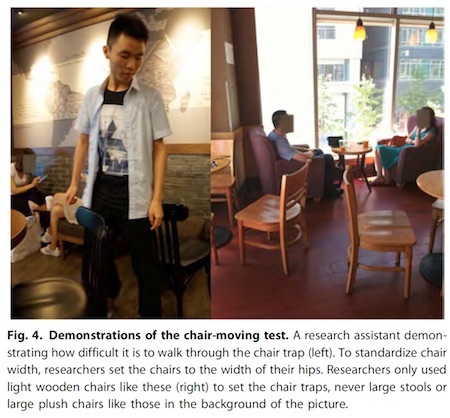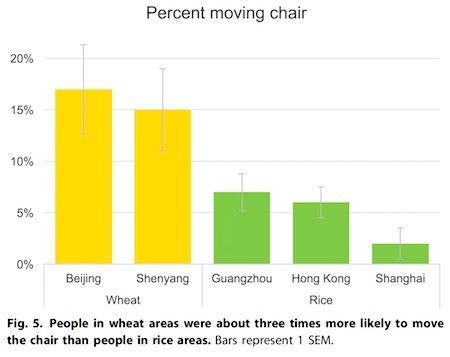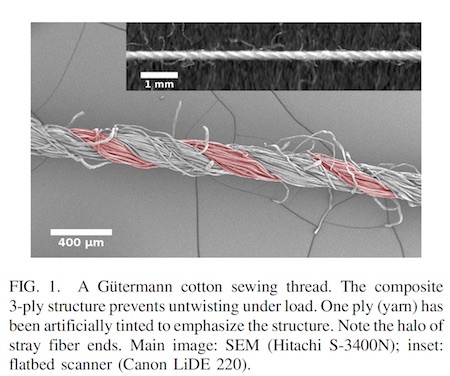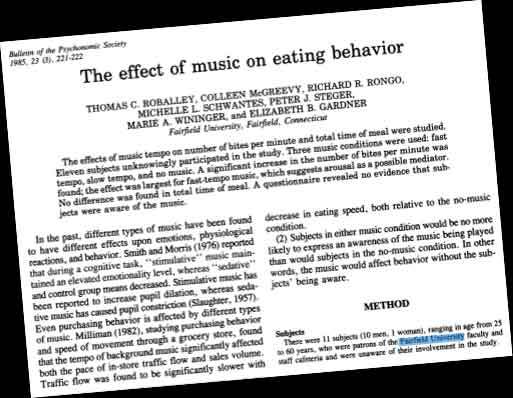Marc Abrahams's Blog, page 189
April 27, 2018
Cigarettes That Are Visually Offputting (research study)
A number of countries have passed laws which require cigarette manufacturers to show ‘denormalising’ images on their packaging. To take things a step further, why not make the cigarettes themselves more unappealing? This was the question tackled by a joint Australian – New Zealand research team in 2015.
A set of potentially unpleasant cigarette designs were experimentally tested – of which the most effectively off-putting was found to be this one :
“The stick featuring the ‘minutes of life lost’ graphic was markedly less appealing and less likely to be chosen than all other sticks tested. “
See: ‘Dissuasive cigarette sticks: the next step in standardised (‘plain’) packaging?’ in Tobacco Control, Volume 25, Issue 6.
Bonus Assignment [optional] What other graphic graphic devices on cigarettes might help dissuade smokers from lighting up?
Also see : ‘How much life does a sausage cost you’ – from the BBC’s Tomorrows World.
And : News of a new study from The Lancet – “each unit [of alcohol] above guidelines is taking, on average, about 15 minutes of life, about the same as a cigarette.”

April 26, 2018
Demonstrating how the frog was able to be levitated by magnets
Joe Schwarcz tells and shows, in this video, how Andre Geim was able to use magnets to levitate a frog (and thus, together with Michael Berry, win an Ig Nobel Prize for physics). Joe Schwarz also talks about Andre Geim’s gekko-stickiness research.

Moving Chairs in Starbucks: Rice-Wheat Cultural Differences in China
The famed Chinese cultural divide — wheat-centric in the north, rice-centric in the south — plays out even in today’s coffee shops, suggests this new study:
“Moving Chairs in Starbucks: Observational Studies Find Rice-Wheat Cultural Differences in Daily Life in China,” Thomas Talhelm, Xuemin Zhang, and Shigehiro Oishi, Science Advances, Vol. 4, no. 4, April 25, 2018: eaap8469. (Thanks to Minna Lyons for bringing this to our attention.) The authors, at Beijing Normal University, China, the University of Chicago, USA, and the University of Virginia, USA, explain:

Traditional paddy rice farmers had to share labor and coordinate irrigation in a way that most wheat farmers did not. We observed people in everyday life to test whether these agricultural legacies gave rice-farming southern China a more interdependent culture and wheat-farming northern China a more independent culture.
In Study 1, we counted 8964 people sitting in cafes in six cities and found that people in northern China were more likely to be sitting alone. In Study 2, we moved chairs together in Starbucks across the country so that they were partially blocking the aisle (n = 678).
People in northern China were more likely to move the chair out of the way, which is consistent with findings that people in individualistic cultures are more likely to try to control the environment. People in southern China were more likely to adjust the self to the environment by squeezing through the chairs. Even in China’s most modern cities, rice-wheat differences live on in everyday life.
This chart presents a featured finding from the study—that “People in wheat areas were about three times more likely to move the chair than people in rice areas”:


April 25, 2018
The insides of a singer singing, and a talker talking
The insides of a singer singing are on display in this video, produced by researchers at the Max Planck Institute for Biophysical Chemistry.
And here’s a look inside a talker talking:
The Max Planck Institute is celebrating some of the work that made this kind of video possible. In particular, they say:
The European Patent Office has nominated physicist Jens Frahm from the Max Planck Institute for Biophysical Chemistry as one of the three finalists in the field of research. The Inventor Award recognizes individual inventors and teams in five categories, whose development helps to find technical answers to the key challenges of our time. The winners will be announced on 7 June 2018 in Paris, Saint-Germain-en-Laye (France).


Treatment for Simulator-Sickness: Insert a Nose
If you spend enough time in a flight simulator or using Virtual Reality goggles, you’re likely to suffer “simulator sickness”. The simulator shows your eyes objects, motions, and distances which don’t match what your other senses are perceiving, which can cause nausea, vertigo, headaches, and other documented symptoms.
Some designers try to lessen the effect by inserting a motionless frame around what the viewer sees – like a virtual dashboard or window frame. One research team decided to insert a nose.

(click on this image for video) Still image from the rollercoaster simulator used to test the nasum virtualis, courtesy of Purdue University and Wired magazine.
Nasum Virtualis: A Simple Technique for Reducing Simulator Sickness (D.M. Whittinghill, Bradley Ziegler, James Moore, and Tristan Case)
“…we placed a three-dimensional model of a virtual human nose in the center of the fields of view of the display of an Oculus Rift: the left display seeing only the left half of the nose model in the lower right corner, the right display seeing only the right half of the nose in the lower left corner. Two groups were tested, the Nose experimental group and the No-nose control group…”
This nose idea was suggested by Bradley Ziegler, then an undergraduate student.
“It was a stroke of genius,” said Whittinghill, who teaches video game design. “You are constantly seeing your own nose. You tune it out, but it’s still there, perhaps giving you a frame of reference to help ground you.”
Adding this virtual nose, or “nasum virtualis”, to the simulated scene delayed the effects of simulator sickness for different amounts of time, depending on the scene being viewed – users riding a virtual rollercoaster gained only a few extra seconds before symptoms began, while those walking around a virtual house gained an extra 94 seconds.
Surprisingly, the test subjects didn’t notice the virtual nose in their field of view.
“It’s a big honking nose… It never occurred to us that they wouldn’t perceive it, but they were almost universally baffled about what we were even talking about.”
BONUS: These test subjects who didn’t notice the nose placed virtually in front of their faces remind us of the 2004 Ig Nobel Prize in Psychology, awarded to the researchers who demonstrated, “…that when people pay close attention to something, it’s all too easy to overlook anything else — even a woman in a gorilla suit.“

April 24, 2018
A physics discovery: Why Clothes Don’t Fall Apart
The UK-based team that shared an Ig Nobel Physics Prize in 2012 for exploring the physics of why ponytails (the hair style) are shaped like pony tails, has now looked into a different question from everyday life: Why clothes don’t fall apart. They published a study about it:
“Why Clothes Don’t Fall Apart: Tension Transmission in Staple Yarns,” Patrick B. Warren, Robin C. Ball, and Raymond E. Goldstein, Physical Review Letters, vol. 120, 2018, 158001. The authors report:

In his celebrated Dialogues Concerning Two New Sciences, Galileo identified a fascinating puzzle in the mechanics of ropes…. From a modern perspective, we would say that the mechanical integrity of ropes derives from frictional contacts between fibers, and Galileo’s rope problem is but one exemplar of a host of related frictional phenomena in fiber assemblies, of which perhaps the canonical case is the ‘staple’ yarn.
The problem of how staple yarns transmit tension is addressed within abstract models in which the Amontons–Coulomb friction laws yield a linear programing (LP) problem for the tensions in the fiber elements. We find there is a percolation transition such that above the percolation threshold the transmitted tension is in principle unbounded. We determine that the mean slack in the LP constraints is a suitable order parameter to characterize this supercritical state. We argue the mechanism is generic, and in practical terms, it corresponds to a switch from a ductile to a brittle failure mode accompanied by a significant increase in mechanical strength.
(Thanks to Joan Codina for bringing this to our attention.)

April 23, 2018
Beats Per Minute affects Bites Per Minute
When it comes to eating in restaurants, some people like ambient music, some don’t like it, and others aren’t bothered one way or the other. But nevertheless, the question can be asked :- does the tempo of the music, measured in Beats Per Minute (BPM) affect customers’ Bites Per Minute (BPM) ?
A unique study, carried out by the Department of Psychology at Fairfield University, Connecticut, US, in 1985, set out to investigate.
“The effects of music tempo on number of bites per minute and total time of meal were studied. Eleven subjects unknowingly participated in the study. Three music conditions were used: fast tempo, slow tempo, and no music. A significant increase in the number of bites per minute was found; the effect was largest for fast-tempo music, which suggests arousal as a possible mediator.”
Oddly perhaps, although uptempo music appeared to increase the number of Bites Per Minute, the total time of meals remained the same. Suggesting that restaurant owners who play fast music to their customers in the hope of increasing turnaround times might be disappointed.
The researchers also noted that :
“A questionnaire revealed no evidence that subjects were aware of the music.”
See: ‘The effect of music on eating behavior‘ in the Bulletin of the Psychonomic Society, March 1985, Volume 23, Issue 3, pp 221–222.

April 20, 2018
Artificial Life Breeds Surprising Duh Moments for Its Programmers
A group of computer programmers collected a bunch of real-life stories about surprising things that happened while they were trying to create “artificial life.” Their story collection is:
“The Surprising Creativity of Digital Evolution: A Collection of Anecdotes from the Evolutionary Computation and Artificial Life Research Communities,” Joel Lehman, Jeff Clune, Dusan Misevic, Christoph Adami, Julie Beaulieu, et al., arXiv:1803.03453v2 [cs.NE], March 29, 2018. (Thanks to Sune Mølgaard for bringing this to our attention.) The authors report:

The process of evolution is an algorithmic process that transcends the substrate in which it occurs. Indeed, many researchers in the field of digital evolution can provide examples of how their evolving algorithms and organisms have creatively subverted their expectations or intentions, exposed unrecognized bugs in their code, produced unexpectedly adaptations, or engaged in behaviors and outcomes uncannily convergent with ones found in nature…. This paper is the crowd-sourced product of researchers in the fields of artificial life and evolutionary computation who have provided first-hand accounts of such cases….
For example, players of NERO are encouraged to place walls around their evolving robots to help them learn to navigate around obstacles. However, somehow evolution figured out how to do something that should have been impossible: the robotic operatives consistently evolved a special kind of ‘wiggle’ that literally causes them to walk up the walls, allowing them to ignore obstacles entirely, and undermining the intent of the game. The NERO team had to plug this loophole, which is apparently a little-known bug in the Torque gaming engine, after which the robots acquiesced to the more respectful policy of politely walking around walls to get to the other side.

April 19, 2018
How to Commit a Perfect Murder [research study]
Perfect murders are more common in actual life than in crime fiction—and also more highly approved, suggests this forensic study:
“How to Commit a Perfect Murder,” Mark Cooney, International Journal of Law, Crime and Justice, vol. 43, 2015, pp. 295-309. The author, at the University of Georgia, explains:
Curiously, social science has ignored the problem of the perfect murder…. Whatever the reason, the neglect is not justified as the topic harbors an important scientific question: when will people get away with murder? Moreover, the data for answering the question already exist. A large body of research conducted by criminologists, anthropologists, historians, sociologists, human rights activists and others provides a wealth of detail about the handling of real-life homicide cases across a broad range of human societies….
Fact… deviates sharply from fiction. In the real world, the perfect murder is not committed by an evil genius but by a moral agent acting in the name of the common good—fighting crime, restoring honor, eliminating enemies, protecting communities. Nor is it a mystery: the killer’s identity is publicly known, and the killing is tolerated, even applauded, by legal officials and by fellow civilians. The killer may even wear the badge of the law. In short, while the perfect murder remains a source of aesthetic fascination, it is no longer a scientific puzzle. To commit a perfect murder, the killer should:
Be of as high status as possible.
Select a low status victim who is, ideally, socially close as well.
Have extensive strong partisanship and the victim none at all.
Be significantly closer, socially, than the victim to those making the crucial decisions in the case.
 Mark Cooney, the study’s author [pictured here], himself pursues the perfect analysis of the perfect crime. His web site notes: “Most of Dr. Cooney’s work employs a theoretical system known as Blackian theory or pure sociology. Deviating from conventional conceptions of reality, pure sociology [explains] human behavior without reference to what people think, feel, or want.”
Mark Cooney, the study’s author [pictured here], himself pursues the perfect analysis of the perfect crime. His web site notes: “Most of Dr. Cooney’s work employs a theoretical system known as Blackian theory or pure sociology. Deviating from conventional conceptions of reality, pure sociology [explains] human behavior without reference to what people think, feel, or want.”

‘JoyGuzzling’ – should one refrain? (new study)
“Our thesis is that there is no moral requirement to refrain from emitting reasonable amounts of greenhouse gases (GHGs) solely in order to enjoy oneself. Joyriding in a gas guzzler (joyguzzling) provides our paradigm example”
– explain Ewan Kingston and Walter Sinnott-Armstrong of the Philosophy Department, Duke University, Durham, NC, US, in a new paper for the journal Ethical Theory and Moral Practice.
“We stress that it may well be optimal or virtuous to refrain from joyguzzling. However, the path to showing a moral requirement to refrain from joyguzzling does seem to contain very difficult hurdles. Approaches that try to show an adequate connection between single acts of emitting and the bad effects of climate change must deal with the fiendish complexity of the causal pathways connecting emissions with extreme weather events and gradual harms.”
See: What’s Wrong with Joyguzzling?, Ethical Theory and Moral Practice, February 2018, Volume 21, Issue 1, pp 169–186.
Note: Professor Sinnott-Armstrong is co-director of MADLAB at Duke.

Marc Abrahams's Blog
- Marc Abrahams's profile
- 14 followers





